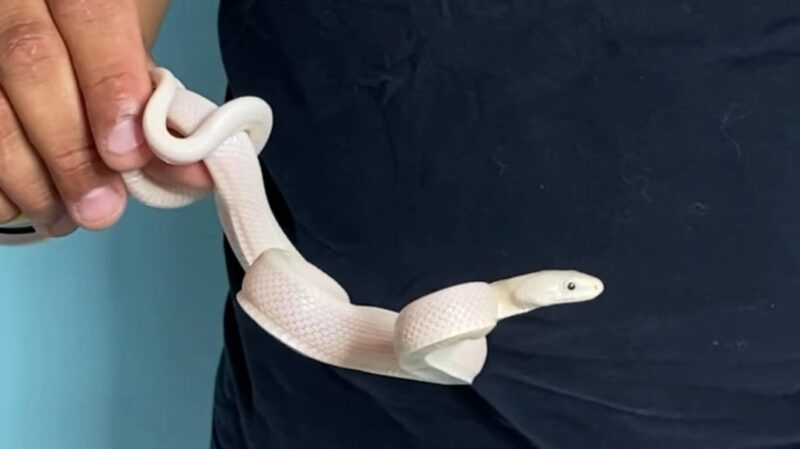Howdy! I’m thrilled you’ve joined me today as we journey into the heart of Texas. Today, we’re not focusing on the usual suspects like cowboys or longhorns. Instead, we’re exploring the world of a creature that’s as Texan as they come – the Texas Rat Snake.
This slithering marvel, scientifically known as Pantherophis obsoletus lindheimeri, is a sight to behold and a testament to the wonders of nature. It belongs to the Colubridae family, which simply means it’s a non-venomous constrictor. But don’t let that fool you, this creature is as captivating as they come.
The aim of our conversation today is to provide a comprehensive overview of this remarkable species. We’ll be comparing it to its relatives, and highlighting what makes our friend stand out.
General Overview
Habitat and Distribution
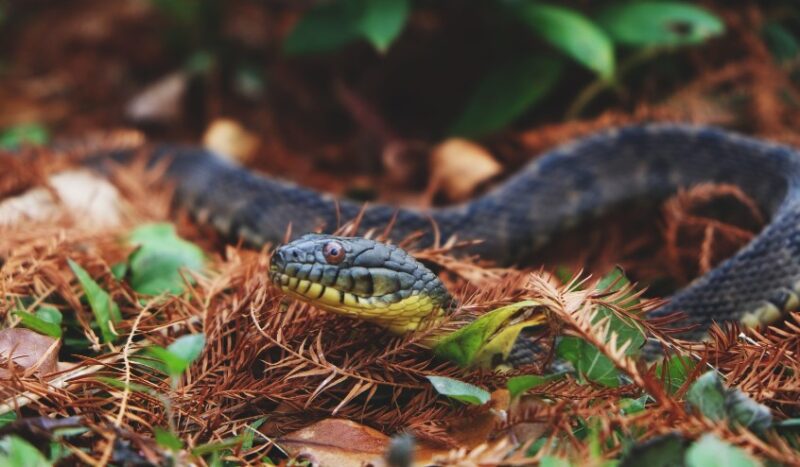
The Texas Rat Snake is a true child of the Lone Star State, with a habitat range that spans across central and eastern Texas, and even stretches into Louisiana and Arkansas. These critters are quite adaptable and can be found in a variety of biomes, from forests and grasslands to suburban neighborhoods. They’re particularly fond of areas near water sources, like rivers and lakes, where prey is abundant.
Compared to other species, the Texas Rat Snake is a bit of a homebody. While its cousins, like the Black Rat Snake, might be found across a broad swath of the United States, our Texas friend prefers to stick closer to home, thriving in the unique ecosystems of the southern central United States.
Physical Characteristics
Now, this snake can be quite intimidating. Adults can grow up to 5 to 6 feet long, making them one of the larger species of rat snakes. They sport a variety of colors and patterns, typically a mix of browns, yellows, and grays, with darker blotches along their bodies. This camouflage helps them blend into their surroundings when hunting or avoiding predators.
Compared to other species, our friend stands out due to its size and distinctive coloration. For instance, the Eastern Variant, while similar in size, tends to have a more uniform black color, while the Corn Snake, another relative, is smaller and has a more vibrant orange-red coloration.
Behavior and Temperament
Primarily nocturnal creatures, they prefer to hunt and be active during the cooler hours of the night. They’re excellent climbers and swimmers, using these skills to pursue prey and evade predators. Despite their size, they’re generally non-aggressive, preferring to flee rather than fight when confronted.
They share many behavioral traits, such as their climbing and swimming abilities with other Rat Snakes. However, they’re often considered more docile than some of their relatives, which are often far more defensive when threatened.
Diet and Prey
When it comes to dining, Texas Rat Snakes aren’t picky eaters. They primarily feed on rodents, birds, and bird eggs, using their constricting abilities to subdue their prey. They play a crucial role in controlling rodent populations, making them a friend to farmers and homeowners alike.
In terms of diet, they’re similar to other rat snakes. However, some species, like the Corn Snake, are known to have a particular fondness for rodents, while our friend has a more varied diet.
Reproduction and Life Cycle
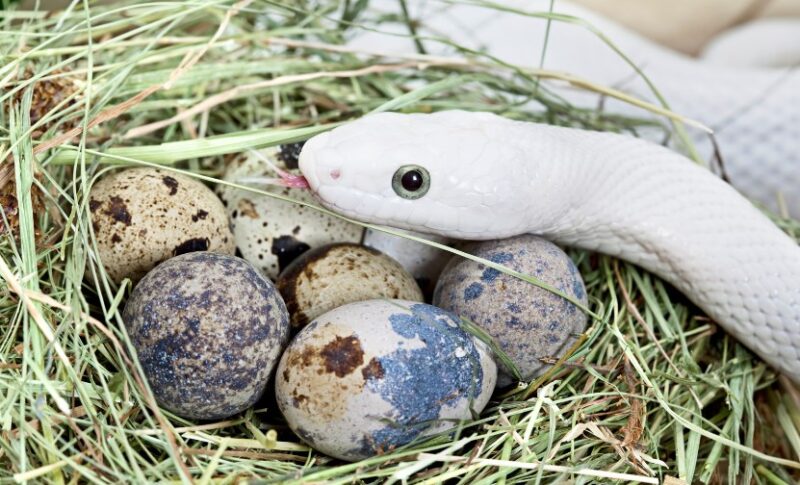
Come springtime, Texas Rat Snakes are ready for love. After mating, females lay around a dozen eggs, which they leave to incubate in a warm, safe spot. The young hatch in late summer, ready to start their journey. They reach sexual maturity in a few years, and the cycle begins anew.
In terms of lifespan, they can live up to 15-20 years in the wild, and even longer in captivity with proper care, often reaching up to 25 years. This longevity is similar to other rat snake species, making them a long-term commitment for those who keep them as pets.
This reproductive strategy is a common one. However, some species, like the Black Rat Snake, tend to lay fewer eggs at a time, while others, like the Corn Snake, often lay more.
Defense Mechanisms
When threatened, the Texas Rat Snake has a few tricks up its sleeve. It might try to scare off predators by vibrating its tail, mimicking the sound of a rattlesnake. If that doesn’t work, it’ll often play dead, hoping the predator will lose interest.
These defense mechanisms are shared with other rat snakes, although the effectiveness can vary. For instance, the mimicry of a rattlesnake’s rattle might be more convincing in the Texas habitat, where rattlesnakes are common, compared to regions where rattlesnakes are less prevalent.
Comparative Anaylisis
Venom and Dangerous Species
Now, Texas is home to a variety of snakes, some of which are venomous, such as the Western Diamondback Rattlesnake and the Copperhead. These venomous species are quite different from our friend. They use venom to immobilize their prey and as a defense mechanism, whereas the Texas Rat Snake uses constriction to subdue its meals.
It’s crucial to correctly identify venomous snakes for your safety and theirs. Misidentifications can lead to unnecessary fear and harm to non-venomous species like the Texas Rat Snake. Remember, a snake’s first instinct is to avoid confrontation, so give them the space they need, and everyone can coexist peacefully.
Interactions with Humans
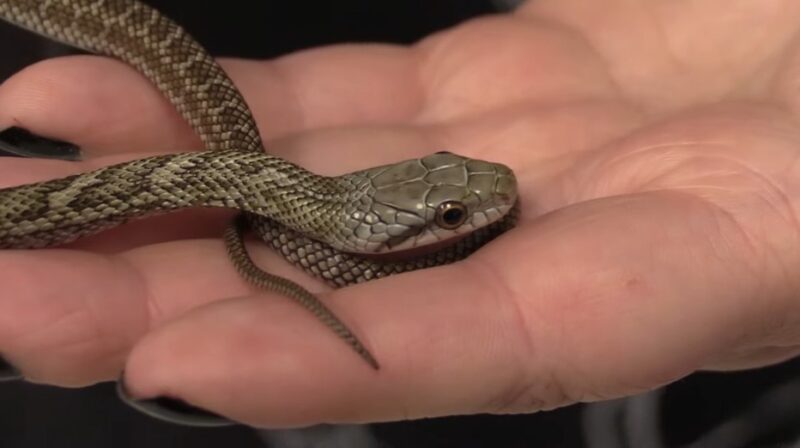
Interactions between humans and Texas Rat Snakes are generally peaceful, especially compared to some other snake species. These snakes are often seen as beneficial due to their role in controlling rodent populations. However, like any wild animal, they can become defensive if they feel threatened.
Conflicts can arise when these snakes venture into human dwellings in search of food or shelter. It’s important to remember that these guys are not aggressive and pose no threat to humans. If you find one in your home, it’s best to call a professional to safely relocate them.
Ecological Role
Their ecological role in texas is vital. By controlling rodent populations, they help maintain a balance in the ecosystem. This role is similar to other species, such as the Black Rat Snake in the eastern U.S. or the Red Rat Snake in the southeast.
However, the impact on local food chains can vary. In areas with high rodent populations, like Texas, their impact can be significant. In contrast, in areas where rodents are less prevalent, their impact is oftenless pronounced.
Conservation Status and Threats
Currently not considered threatened or endangered. This is similar to many other species, like the Corn Snake or the Black Rat Snake. However, like all wildlife, they face threats from habitat loss and human interference.
Worldwide, rat snakes face threats from habitat destruction, climate change, and in some cases, over-collection for the pet trade. It’s essential to protect these creatures and their habitats to maintain the balance of our ecosystems.
Human Perceptions and Folklore
Rat snakes, have been subjects of folklore and cultural beliefs. In some cultures, they’re seen as symbols of fertility and transformation due to their shedding process. However, attitudes towards these creatures can vary greatly.
In Texas, the Rat Snake is often seen as a beneficial creature due to its role in controlling pests. This positive perception is not always shared with other species, especially in areas where they’re less common or where snakes are generally viewed with fear or suspicion.
Captivity and Pet Trade
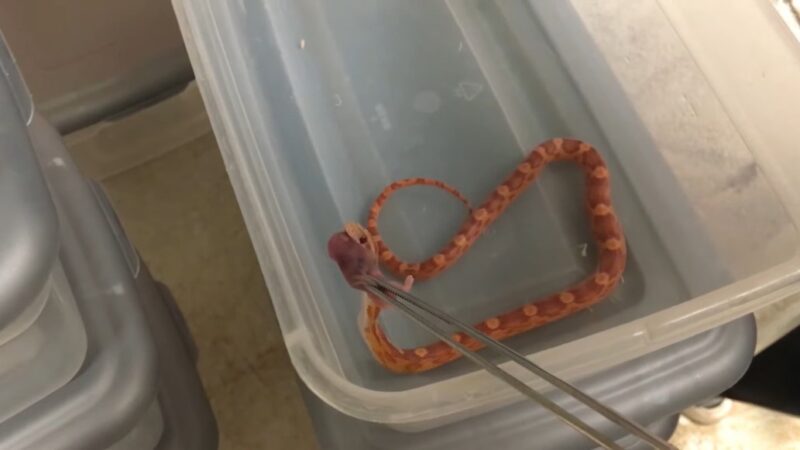
Rat snakes, are often kept as pets due to their docile nature and relatively easy care requirements. They’re generally more tolerant of handling compared to some other snake species, making them a popular choice for beginners.
However, the pet trade can have an impact on wild populations. Over-collection can lead to local declines, and released or escaped pets can introduce diseases into wild populations. It’s crucial to source any pet snake from a reputable breeder to ensure they’re not contributing to these issues.
Final Thoughts
As we wrap up our journey into the world of the Texas Rat Snake, it’s clear that this creature is a remarkable testament to the wonders of nature. From its distinctive coloration and impressive size to its vital role in controlling rodent populations, the Texas Rat Snake is a true embodiment of the Lone Star State’s rich biodiversity.
While it shares many traits with its rat snake relatives, the Texas Rat Snake stands out in its own unique ways. Its adaptability to a variety of habitats, its varied diet, and its docile nature make it a fascinating creature to study and observe. Whether it’s seen slithering in the wild or kept as a pet, this snake continues to captivate us with its intriguing characteristics.
The Texas Rat Snake, like all wildlife, deserves our respect and protection. It plays a crucial role in maintaining the balance of our ecosystems and serves as a reminder of the intricate web of life that exists in our world. So, the next time you’re in the heart of Texas, keep an eye out for this slithering marvel. Who knows, you might just be lucky enough to spot one in its natural habitat!
We hope that you learned something new about the famous Lone Star’s serpentine, including its diet, reproduction, and habitat. Now, armed with this expert knowledge, you can compare it to the secrets of survival and reproduction found in banded water snakes.
Related Posts:
- Banded Water Snake: Facts, Diet, Habitat - Secrets…
- Squirrel Vs Rat Poop - How to Tell the Difference
- Harmony in the Habitat: 5 Tips for Feeding Wild…
- What Do Weasels Eat? - Diet, Lifestyle, and Adaptations
- What Do Black Bears Eat? Insights into Their Diet
- What Do Foxes Eat? Wild & Urban Fox Diet Info & Habits


